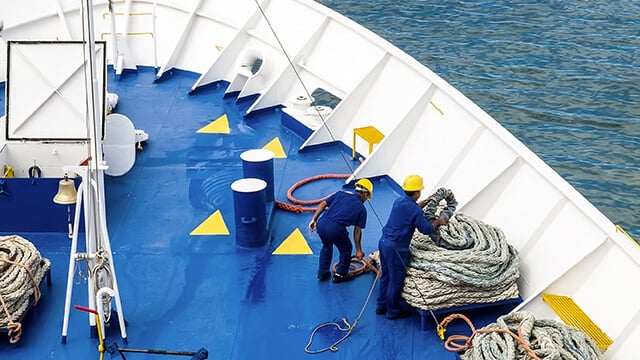Campaña de Inspección Concentrada (CIC) enfocada en la gestión del agua de lastre
From September to November 2025, maritime administrations belonging to the Paris and Tokyo Memorandums of Understanding (MoU) will run a Concentrated Inspection Campaign (CIC) focused on ballast water management. During this period, you can expect questions from Port State Control when entering ports belonging to the 50 MoU administrations. Both your crews and your ballast water management systems (BWMS) need to be ready.
To help you clear the CIC without deficiencies, detentions or fines, we’ve gathered the following on this page:
- The reasons and risks
- What to expect during inspection
- Guidance for preparing crews and BWMS
- Specific support for owners of Alfa Laval PureBallast systems
- Links to related issues
Understanding the CIC
Concentrated inspection campaigns take place each year, targeting areas where the risk of non-compliance is high. In 2025, the CIC spotlight will fall on ballast water management for the first time.
As of September 2024, all vessels subject to the IMO Ballast Water Management Convention should have a BWMS installed. They should already be complying with the D-2 biological performance standard and the rest of the convention’s requirements. However, authorities have seen many deficiencies in recent years.
The CIC aims to put focus on this issue, ensuring that deficiencies are found and corrected at an early stage. Port State Control officers from the 50 MoU administrations will check foreign-flagged arriving vessels using a dedicated questionnaire.
If Port State Control officers identify deficiencies during the CIC, your vessel could be detained or fined.
How common are ballast water management deficiencies?
Enforcement of the IMO Ballast Water Management Convention is currently in an experience-building phase (EBP), which is set to end in 2026. During the EBP, there is no penalty for failure to meet the D-2 biological performance standard so long as:
- The BWMS is correctly approved, installed and maintained
- The vessel’s Ballast Water Management Plan has been approved and followed
- The BWMS is working properly, or the port state has been informed of any issue prior to discharging ballast water
In practice, many vessels have failed to meet these simple conditions. While vessels are seldom detained for individual deficiencies, ballast water management has played a role in numerous detentions.
The chart below shows recent deficiencies in ballast water management, based on Memorandum of Understanding (MoU) data. The most common are deficiencies in the Ballast Water Record Book, where either the entries were not made properly or the book itself was missing.
How can you avoid issues during the CIC?
The CIC questionnaire targets aspects of ballast water management that have led to repeated deficiencies. These include system documentation and operability, but also crew familiarization. Crews must show Port State Control officers they can manage the BWMS correctly – from regular maintenance to following procedures for challenging water quality (CWQ) defined in the Ballast Water Management Plan.
It isn’t enough to simply have a BWMS on board. To avoid issues during the CIC, both the BWMS and the crew must be prepared.
Preparing for the CIC
Technically, nothing in the CIC is new. Everything the CIC requires is already demanded by the IMO Ballast Water Management Convention. But you’ll need prove your compliance during the CIC, which comes down to three types of readiness.
1. Document readiness
Port State Control officers will want to see your key documents for ballast water management. These include:
- The International Ballast Water Management Certificate for your vessel. This certificate can only be issued after biological commissioning testing of the installed BWMS.
- An approved Ballast Water Management Plan. This must detail a wide range of routines, from ballast water management itself to safety procedures and BWMS maintenance. While not strictly required, it’s also a good idea to include procedures for challenging water quality (CWQ) or contingency measures that the vessel will rely on.
- Your Ballast Water Record Book, which should follow the updated guidance that entered into force in February 2025. All BWMS operations must be recorded in a timely manner and with the correct codes.
Be sure these documents are accessible, correct and in line with today’s requirements.
2. System readiness
Port State Control officers will expect your BWMS to be in good working order. They will check the state of its key components and make sure the treatment process is functional. If your BWMS uses active substances, they will also check that sufficient consumables are on board. Generally speaking, you should keep an eye on all critical inventory – including spare parts – so that system readiness is always possible to restore.
In short, your BWMS must be properly maintained and able to operate according to its type approval. If you need guidance, reach out to the BWMS supplier, who may also have packages for maintenance support.
3. Crew readiness
Above all, your success in the CIC depends on the crew – who must handle BWMS maintenance, BWMS operations and the ongoing documentation of ballast water management. Port State Control officers will check that crew members understand and fulfil their duties, even under challenging water quality (CWQ) conditions. In addition, there must be a designated crew officer with responsibility for ballast water management procedures and documentation.
BWMS logs and alarms will be compared against the Ballast Water Management Plan and entries in the Ballast Water Record Book. So crew knowledge and follow-through are vital. Speak to your BWMS supplier to arrange the proper training, and ask about connectivity or other solutions that can facilitate accurate recordkeeping.
Ten top tips for success in CIC 2025
To help you get ready for the CIC, we’ve prepared a concise but specific set of tips. Here you’ll find more about individual items that Port State Control officers will be looking for. In addition, you’ll learn where you can turn for additional guidance.

CIC support for Alfa Laval PureBallast owners
Your best partner in preparing for the CIC is the supplier who provided your BWMS. As a PureBallast owner, you can count on comprehensive assistance from Alfa Laval.
We’re ready to support you, from answering your service questions and urgent needs for PureBallast spare parts to providing guidance on procedures for challenging water quality (CWQ). In addition, we have specific service offerings that can help prepare crews and PureBallast systems for success in the CIC.
PureBallast training
In the CIC, crews must demonstrate their familiarity with the BWMS on board. They need to show that they understand their duties in ballast water management – and that they are able to fulfil them. So make sure they have the knowledge they need to operate and maintain PureBallast. We offer a range of PureBallast training options, including e-learning.
PureBallast Compliance Service Package
The CIC targets regulatory compliance. For BWMS, the IMO regulations demand maintenance according to the manufacturer’s instructions, as well as crew familiarity with the system. With the PureBallast Compliance Service Package, our experts take responsibility for these aspects and more – taking work and worry off your shoulders. The package combines everything you need for compliance with a predictable preventive maintenance cost.
Updated VisuALog software
BWMS logs will be checked during the CIC. So be sure you have the latest offline version of the Alfa Laval VisuALog software that was delivered with your PureBallast system. (If your version is older than VisuALog 3.0, please contact us to update.) VisuALog creates easy-to-understand visual reports that will simplify for Port State Control officers, who may otherwise have difficulty interpreting BWMS logs.
With VisuALog, you can easily verify that all BWMS operations have been entered into the Ballast Water Record Book. Using the online version, you can do this without manually retrieving log files. The online version of VisuALog is integrated into PureBallast Connect, a digital service portal that offers many additional possibilities.
Related issues
Evaluating BWMS replacement
The CIC focus on ballast water management is no coincidence. It’s a response to the many deficiencies already identified among BWMS. If you currently have BWMS issues and your supplier is unable to support you, BWMS replacement may be an option worth examining.

Understanding challenging water quality (CWQ)
Port State Control officers will review your Ballast Water Management Plan as part of the CIC, checking the crew’s understanding and ability to follow it correctly. Before performing a reactive bypass in CWQ conditions, you must consult the authorities – unless the procedure is clearly defined in your plan. Make sure you know what applies – and what doesn’t – by reading our white paper.
Understanding biological commissioning testing
During the CIC, Port State Control officers will verify that you have a valid International Ballast Water Management Certificate on board. This vessel-specific certificate is not the same as a BWMS type approval. To receive it, your individual BWMS installation must be verified through biological commissioning testing.



